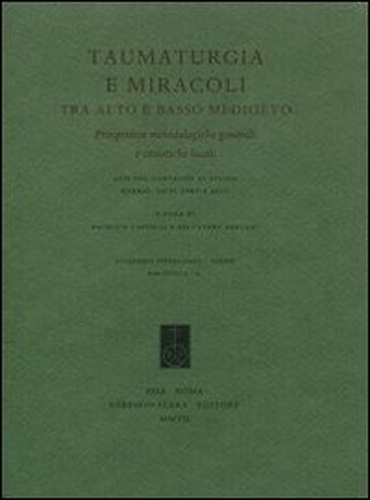 --
Taumaturgia e miracoli tra alto e basso Medioevo. Prospettive metodologiche generali e casistiche locali. Atti del Convegno di studio (Gubbio, 20-21 aprile 2007).
--
Taumaturgia e miracoli tra alto e basso Medioevo. Prospettive metodologiche generali e casistiche locali. Atti del Convegno di studio (Gubbio, 20-21 aprile 2007).
Gubbio, 20-21 aprile 2007. A cura di Patrizia Castelli e Salvatore Geruzzi. Pisa, Fabrizio Serra Editore
2008,
cm.18,5x25,
pp.XVI,180, illustrazioni.
brossura.
Collana Accademia Sperelliana di Gubbio. Biblioteca, 2.
Nei contributi raccolti in questo volume si è voluto selezionare testimonianze diversificate relative alla storia della taumaturgia e dei miracoli, con particolare attenzione al potere salvifico ed all'uso delle reliquie in un contesto religioso e civile dalla tarda antichità fino al basso Medioevo. I saggi intendono mostrare come tali aspetti non siano limitati a particolari fasi del cristianesimo, ma abbiano avuto un loro sviluppo anche nell'ambito dell'ellenismo, all'interno di un entourage pagano, come testimoniano le vicende di Elio Aristide (m. 189 d. C.). È fatto noto che la storia del cristianesimo è punteggiata da una bianca coltre costituita da "frammenti di ossa che erano diversi da tutti gli altri frammenti di ossa, tombe che erano diverse da tutte le altre tombe". Queste ossa e queste tombe sono state non solo le vigili sentinelle della cristianità e la testimonianza del paradiso in terra, ma erano e sono gli avamposti e le roccaforti della fede, come testimoniano le vite dei santi e il culto a loro devoluto. Le storie qui raccolte rintracciano eventi occorsi a gente comune e a santi, papi, sacerdoti, così come sono riportati nelle testimonianze agiografiche e nelle fonti cronacristiche; storie, in genere, apologetiche ed esemplative. I vari contributi vogliono indicare una strada da seguire per delineare una "geografia" dei miracoli del primo cristianesimo e per proporre un'attenzione maggiore verso il fine e l'uso dei miracoli in ambito religioso e civile, definendo di volta in volta gli specifici contesti.Sommario: P. Castelli, Introduzione; C. Moreschini, Gregorio il Taumaturgo e la cristianizzazione dell'Asia Minore; C. O. Tommasi Moreschini, Magistero del corpo, magistero della parola. Asclepio dio di salvezza secondo Elio Aristide (e altre figure di maghi e taumaturghi pagani); P. Castelli, Corpi smembrati: reliquie e demoni; I. Fedozzi, Il corpo che non c'è: il culto di san Guido di Pomposa; A. Benvenuti, Reliquie e identità cittadina. Il ruolo delle memorie d'Oltremare nella costruzione del prestigio civico; I. Gagliardi, Bisanzio a Siena: importazione di reliquie, culti e rappresentazione civica tra Trecento e Quattrocento; E. Rossi, "Miracula post obitum patrata": la taumaturgia dei corpi dei santi nella Toscana medievale. Indice dei manoscritti. Indice dei nomi di persona e degli autori.
EAN:
9788862270328
Nuovo